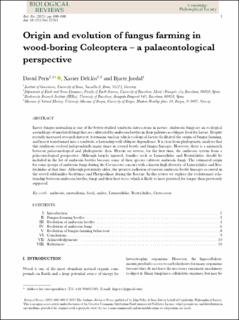| dc.contributor.author | Peris, David | |
| dc.contributor.author | Delclòs, Xavier | |
| dc.contributor.author | Jordal, Bjarte Henry | |
| dc.date.accessioned | 2022-02-28T13:57:19Z | |
| dc.date.available | 2022-02-28T13:57:19Z | |
| dc.date.created | 2022-01-27T13:18:45Z | |
| dc.date.issued | 2021 | |
| dc.identifier.issn | 1464-7931 | |
| dc.identifier.uri | https://hdl.handle.net/11250/2981769 | |
| dc.description.abstract | Insect–fungus mutualism is one of the better-studied symbiotic interactions in nature. Ambrosia fungi are an ecological assemblage of unrelated fungi that are cultivated by ambrosia beetles in their galleries as obligate food for larvae. Despite recently increased research interest, it remains unclear which ecological factors facilitated the origin of fungus farming, and how it transformed into a symbiotic relationship with obligate dependency. It is clear from phylogenetic analyses that this symbiosis evolved independently many times in several beetle and fungus lineages. However, there is a mismatch between palaeontological and phylogenetic data. Herein we review, for the first time, the ambrosia system from a palaeontological perspective. Although largely ignored, families such as Lymexylidae and Bostrichidae should be included in the list of ambrosia beetles because some of their species cultivate ambrosia fungi. The estimated origin for some groups of ambrosia fungi during the Cretaceous concurs with a known high diversity of Lymexylidae and Bostrichidae at that time. Although potentially older, the greatest radiation of various ambrosia beetle lineages occurred in the weevil subfamilies Scolytinae and Platypodinae during the Eocene. In this review we explore the evolutionary relationship between ambrosia beetles, fungi and their host trees, which is likely to have persisted for longer than previously supposed. | en_US |
| dc.language.iso | eng | en_US |
| dc.publisher | Wiley | en_US |
| dc.rights | Attribution-NonCommercial-NoDerivatives 4.0 Internasjonal | * |
| dc.rights.uri | http://creativecommons.org/licenses/by-nc-nd/4.0/deed.no | * |
| dc.title | Origin and evolution of fungus farming in wood-boring Coleoptera – a palaeontological perspective | en_US |
| dc.type | Journal article | en_US |
| dc.type | Peer reviewed | en_US |
| dc.description.version | publishedVersion | en_US |
| dc.rights.holder | Copyright 2021 The Authors | en_US |
| cristin.ispublished | true | |
| cristin.fulltext | original | |
| cristin.qualitycode | 1 | |
| dc.identifier.doi | 10.1111/brv.12763 | |
| dc.identifier.cristin | 1991358 | |
| dc.source.journal | Biological Reviews | en_US |
| dc.source.pagenumber | 2476-2488 | en_US |
| dc.identifier.citation | Biological Reviews. 2021, 96 (6), 2476-2488. | en_US |
| dc.source.volume | 96 | en_US |
| dc.source.issue | 6 | en_US |

